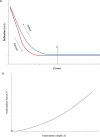Atomic force microscopy probing in the measurement of cell mechanics
- PMID: 20463929
- PMCID: PMC2865008
- DOI: 10.2147/ijn.s5787
Atomic force microscopy probing in the measurement of cell mechanics
Abstract
Atomic force microscope (AFM) has been used incrementally over the last decade in cell biology. Beyond its usefulness in high resolution imaging, AFM also has unique capabilities for probing the viscoelastic properties of living cells in culture and, even more, mapping the spatial distribution of cell mechanical properties, providing thus an indirect indicator of the structure and function of the underlying cytoskeleton and cell organelles. AFM measurements have boosted our understanding of cell mechanics in normal and diseased states and provide future potential in the study of disease pathophysiology and in the establishment of novel diagnostic and treatment options.
Keywords: atomic force microscopy; cell elastography; cell force spectroscopy; cell mechanics.
Figures


References
-
- Zhu C, Bao G, Wang N. Cell mechanics: mechanical response, cell adhesion, and molecular deformation. Annu Rev Biomed Eng. 2000;2:189–226. - PubMed
-
- Elson EL. Cellular mechanics as an indicator of cytoskeletal structure and function. Annu Rev Biophys Chem. 1988;17:397–430. - PubMed
-
- Pourati J, Maniotis A, Spiegel D, et al. Is cytoskeletal tension a major determinant of cell deformability in adherent endothelial cells. Am J Physiol. 1998;247:C1283–C1289. - PubMed
-
- Trickey WR, Vail TP, Guilak F. The role of the cytoskeleton in the viscoelastic properties of human articular chondrocytes. J Orthop Res. 2004;22:131–139. - PubMed
Publication types
MeSH terms
LinkOut - more resources
Full Text Sources
Miscellaneous

